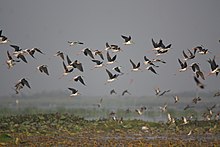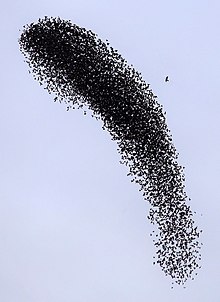
Back سرب Arabic Sürü Azerbaijani Зграя BE-X-OLD Ято Bulgarian Bandada Catalan Hejno Czech Sværm Danish Birdaro Esperanto Bandada Spanish Parv (bioloogia) Estonian


A flock is a gathering of individual birds to forage or travel collectively.[1] Avian flocks are typically associated with migration. Flocking also offers foraging benefits and protection from predators, although flocking can have costs for individual members.[2]
Flocks are often defined as groups consisting of individuals from the same species. However, mixed flocks consisting of two or more species are also common. Avian species that tend to flock together are typically similar in taxonomy and share morphological characteristics such as size and shape.[3] Mixed flocks offer increased protection against predators, which is particularly important in closed habitats such as forests where early warning calls play a vital importance in the early recognition of danger. The result is the formation of many mixed-species feeding flocks.[4]
- ^ "Flock". Dictionary. Retrieved 11 November 2017.
- ^ Gill, Frank (2007). Ornithology. New York, NY: W.H. Freeman and Company.
- ^ "Animal Behaviour: Benefits of Mixed Flocks". Nature. 492 (7429): 314. 19 December 2012. Bibcode:2012Natur.492Q.314.. doi:10.1038/492314a. S2CID 49906236.
- ^ Terborgh, J (2005). "Mixed flocks and polyspecific associations: Costs and benefits of mixed groups to birds and monkeys". American Journal of Primatology. 21 (2): 87–100. doi:10.1002/ajp.1350210203. PMID 31963979. S2CID 83826161.